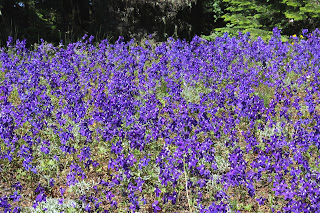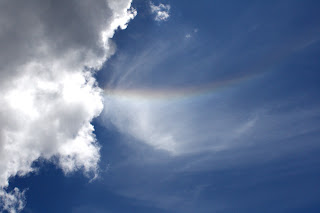In 2017, the Blanket Fire burned around 5,000 acres of the southwest corner of Crater Lake National Park, along with a much larger tract of the Rogue River National Forest. Flash forward five years and the area is well on its way to recovery and is beautiful in its own stark way. However, the lack of viable forest meant that much of our thirteen-mile hike to Stuart Falls was done in open sunlight, which can get pretty warm in this summer of global warming. And surprise of surprises, the heat got to me.
 |
| "But Richard said this hike was easy!" |
There is a shorter route to Stuart Falls that approaches from the west but I'm not sure if that trail or trailhead is open, given the fire that wreaked so much havoc in the area in 2017. Besides which, there's so much more glory to be gained by hiking the thirteen mile route beginning from Crater Lake National Park. I enticed Cleve, Terry, Edwin, and Missy to come along by telling them it was only ten miles long and it was all downhill, purposely omitting the part about having to walk uphill in the hot sun on the way back.
 |
| The Pumice Flat Trail was flat and full of pumice |
We started out on the Pumice Flat Trail, which basically follows an old roadbed through some relatively thin forest. In keeping with its name though, the one overriding feature of the Pumice Flat Trail is that it is virtually flat for three miles in what is a rather utilitarian route to the Pacific Crest Trail.
 |
| Typical forest scene on the Stuart Falls Trail |
We'd only be on the PCT for a hiker's minute though, as we'd peel off onto the Stuart Falls Trail and basically commence the real hike. Here, the PCT runs along a ridge perched above the headwaters of Red Blanket Creek and the Stuart Falls Trail would then drop us several miles down into the creek’s canyon. The fire damage was readily apparent as the Stuart Falls Trail was surrounded by a vast expanse of dead trees.
 |
| Paintbrush livened up the rock gardens |
Despite the death and destruction surrounding the faint (at times) trail, the hike was eminently beautiful. Green grass, fireweed, and bracken fern carpeted the ground beneath the tree skeletons in vegetative homage to the increased post-fire sunlight. Rocky outcroppings cropped up above the trail, and rock gardens abounded. Stuffed into cracks between individual boulders were stonecrop, blooming pale yellow; and paintbrush with its eye-scalding bright red color.
 |
| If the trees were living, we wouldn't be able to see Tom and Jerry Mountain(s) |
I'm beginning to sound like an advocate of burn areas as I continue to extol the virtues thereof, and one of those virtues was increased visibility due to the dearth of live trees. Readily visible, the nearest peak to us was the symmetrical volcanic cone of Goose Egg. There was a complex of more rugged peaks to the west that were Tom and Jerry Mountain, located in the Seven Lakes area. And let us not forget the disturbingly-named Bald Peak looming on the north side of Red Blanket Creek's canyon.
 |
| Sketchy trail, to put it mildly |
Because of the abundance of meadows and flourishing vegetation, the trail was overgrown and very sketchy, to state it charitably. But while it was challenging to stay on course, it never got to the point where the tread completely disappeared. More concerning was the continual loss of elevation as we hiked. It was nice to hike downhill but we all knew that an arduous hike back up to the PCT awaited us on the return leg.
 |
| Stuart Falls was simply beautiful |
Finally, we arrived at a backpacking campsite next to Red Blanket Creek. And just upstream was Stuart Falls itself, delicately fanning white across a cliff comprised of dark black rock. Much oohing and aahing took place and we all scrambled upstream to the base of the falls, happy to bask in the cool mist emanating from the cascade.
 |
| All those trees and no shade |
After a lengthy lunch and general all-around gawkery at the picturesque waterfall, it was time to begin the slog back up to the PCT. By now the day had warmed up considerably and with no shade to shelter us from the sun, the hiking became as scorching as an illicit affair. I noticed that my legs felt tired and my mouth was as dry as the dust my listless feet were kicking up, no matter how much water I drank. My real cause for worry came when the dry heaves started. The struggle was real but I hiked piecemeal, making frequent stops along the way. So not fun.
 |
| Life flourishes at the feet of dead trees |
I was so glad to reach the PCT, for it would be flat and slightly downhill to the trailhead. Even though the forest surrounding the trail was thin and sparse, faint shade is better than no shade at all, like in the tree graveyard within Red Blanket Creek's canyon. The hike was closed out in the lengthening afternoon shadows and despite the travails of the heat, I really did enjoy the beauty of the scenery I had been retching in.
 |
| Typical scenery along the trail |
At the trailhead, Missy doled out seltzer water from an ice chest she had hidden in her car. My recovery was immediate and total upon drinking the precious liquid, although I think we would have all been better served if she would have toted the ice chest down to Stuart Falls.
 |
| Red Blanket Creek, below Stuart Falls |
For more photos of this hike, please visit the Flickr album.









.jpg)
































